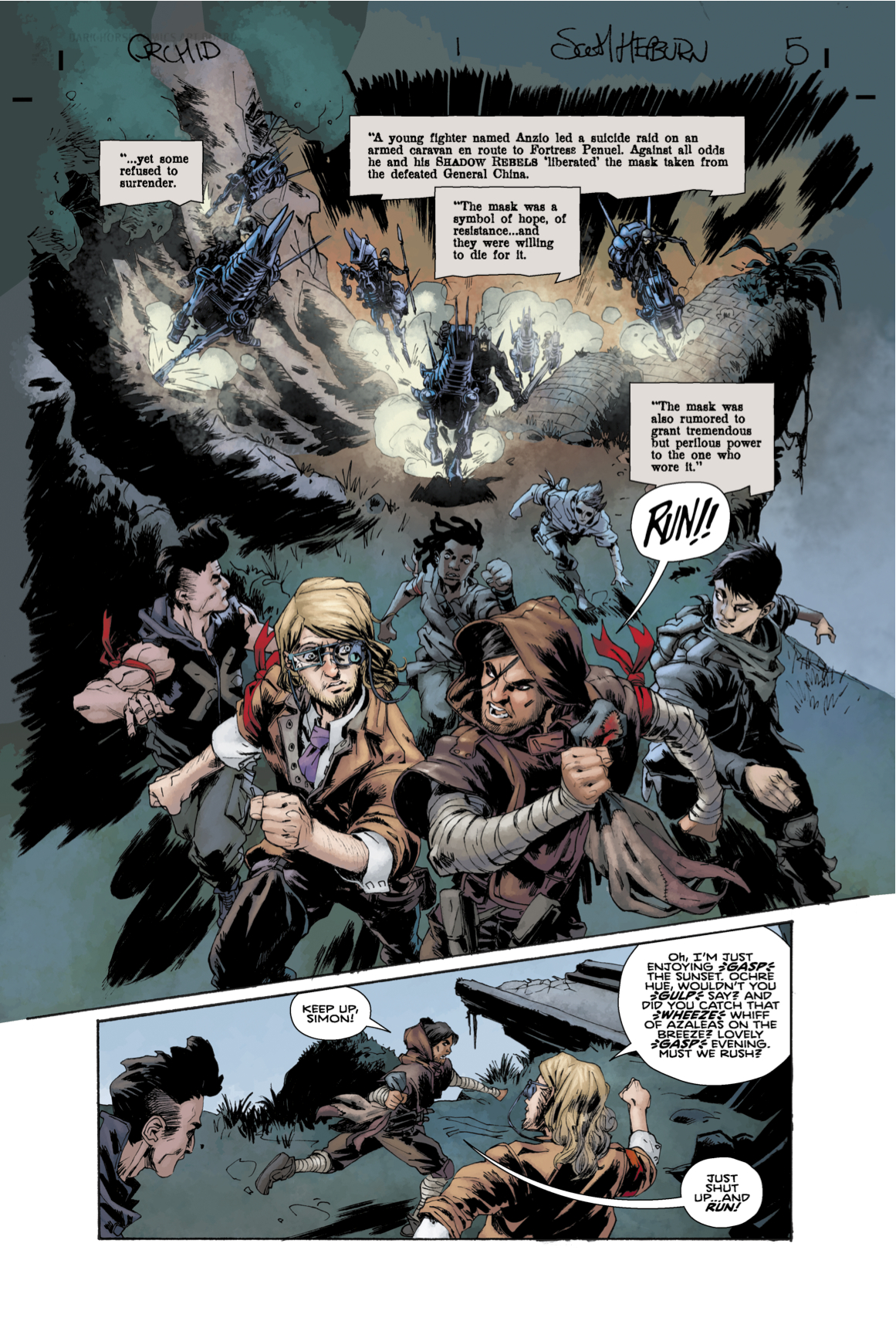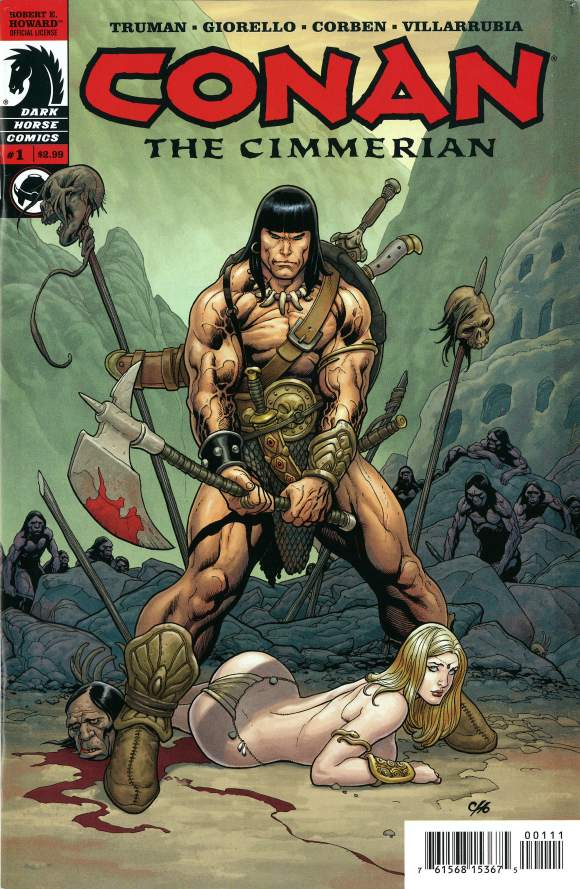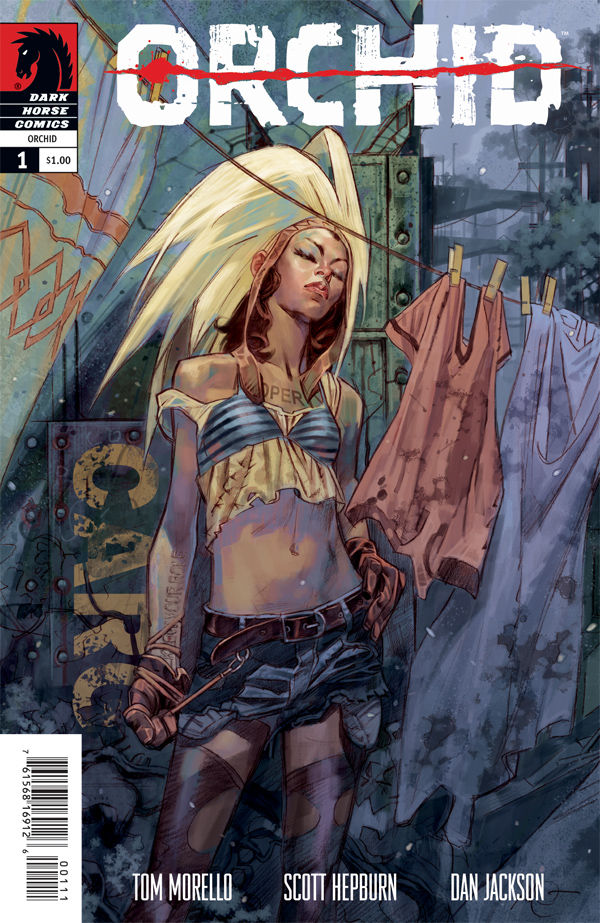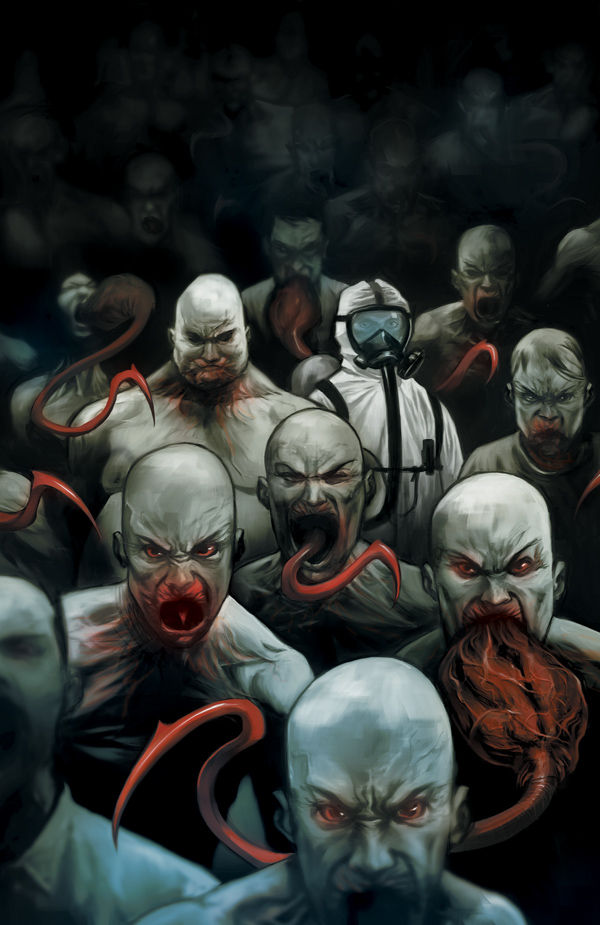Creating comic books is hard work. No, not Deadliest Catch-level hard, but still no easy task. And the end product of said hard work (a comic book) is even more fulfilling than Alaskan king crab. Before this metaphor gets out of control (Davy Jones’ Locker! Starboard bow! Stop me!), let’s dive into (that one was purely accidental) an interview I conducted with Jim Gibbons, an Assistant Editor at Dark Horse Comics. Dark Horse publishes great comics every month, including Star Wars, Hellboy and Buffy the Vampire Slayer. Below, Jim tells us a what it takes to make comics a reality and also gives us a glimpse into the projects he’s working on. Read on, landlubbers! And that’s the end of the water-metaphors, I swear.
Can you tell me about what you do as an Assistant Editor? What’s an average day like?

JIM GIBBONS: My responsibilities are divided into two types of work: managerial-style paper work and creative work. The “paper work” side of being an assistant editor is in no way glamorous, but it’s a necessary part of the process. A lot of this work is essential for taking the beautiful artwork and clever scripts our creators provide us with and making them into actual comic books. Pick any part of a comic that seems extraneous to readers and that’s a task an assistant editor will often tackle. I reformat scripts so the letterer knows exactly who says what and when. I compile letters for letter columns. I write work orders for our design department with instructions on what’s needed to create our inside front covers, cover designs, and logos, which include items like the proper names for the credits and the “last issue” text. I also help lay out bookmaps for our comics, which maps which pages fall where and where ads go. All of this, of course, needs final approval from the book’s head editor, who also assigns me these jobs. Just to clarify, I call this the non-glamorous part and I call it grunt work, but I’m not complaining. Every job requires a bit of grunt work and, at the end of the day, my grunt work is part of making comics for a living. It’s much, much better than filling out TPS reports a la Office Space. Much, much better.
As a detail nerd, I have to say that the “paper work” side of your job fascinates me almost as much as the creative side. It still sounds a lot more interesting than average office work.
Oh yeah, paper work that leads to the existence comic books is far preferable to your average, everyday office job’s monotony. And yet, it’s paper work all the same. You might have the world’s best-looking male pattern baldness (The Picard, let’s call it.), but you’re still bald, ya know?
The creative side of the job is the really fun part. This aspect of the gig includes everything from brainstorming artists and writers we want to hire for particular projects, providing notes on scripts, looking over art and making sure it jibes with the story and script, helping provide notes to our writers and artists, coming up with cover art concepts, and much, much more. Much like the grunt work, all of this work must go through my head editor for final approval, but this is the part where I actually get a chance to provide a few creative nuggets that—hopefully—end up improving the final product. These can be anything from little suggestions that might be incorporated into the work and make me go, “Holy shit! That’s my tiny suggested tweak in the corner of that cover!” It’s a lot of fact checking, as well. “That character should be wearing red. The source material says her hair is blonde.” Sometimes it’s bigger stuff than that, but in the end, I’m a pretty small cog in the big machine that puts together the comic books that readers eventually see on shelves.
Thankfully, I’m fortunate enough to be working on some pretty big upcoming books with very collaborative editors that not only allow the low man on the totem pole (me!) to chime in incessantly, but they also listen to what I have to say. That doesn’t mean they think every suggestion I make is a good one, of course, but that’s part of the fun of working for smart people with a lot of experience—you learn a lot! I consider myself very lucky to be working on comics with editors Sierra Hahn (Angel & Faith, Green River Killer) and, from time to time, Scott Allie (Hellboy, Buffy the Vampire Slayer). They’ve both been kind enough to make me a big part of the books I am currently working on, specifically Ms. Hahn, who I work with on the vast majority of my current work load. The two of them shepherded me into the editorial department from my old job in the publicity department and they have spent a lot of time teaching me the ropes. I owe them a lot when it comes to getting to work day in and day out on something I love: Comics!
Comic book gigs don’t seem to come along often, especially in this economic climate. How did you luck out and what led to your to working at Dark Horse?

In 2009, I got let go from my job as an associate editor for Wizard magazine. It turned out to be some very fortuitously timed bad news, as it happened just a few days before an open PR position at Dark Horse stopped accepting applications. Josh Wigler, current MTV Movies Blog and MTV Splash Page editor extraordinaire, very good friend, and former Wizard co-worker, was actually the guy who alerted me about the opening. I essentially owe him a beer every time I see him for that! I sent in my resume and crossed my fingers. Thankfully, as anyone getting let go from Wizard was kind of newsworthy back in 2009, a lot of people knew I was looking for a new job and a bunch of amazing folks, including DC‘s Brian Cunningham and Archaia‘s Mel Caylo to name a few, got in touch with Dark Horse’s Director of Public Relations, Jeremy Atkins, and put in a good word for me. Having just written a “Book of the Month” feature in Wizard about how much I loved Dark Horse’s Conan the Cimmerian didn’t hurt either, I’m sure. Anywho, a few weeks and a few phone interviews later, Jeremy called up to offer me the job of Publicity Coordinator. I packed up all my stuff in a U-Haul, drove from Jersey to Portland, and began working at DH.
How did you transition out of the publicity department and into editorial?
At a certain point, six to eight months in or so, Señor Atkins and a few other folks I was working with regularly in PR, specifically Scott Allie, took notice of my passion for comics and asked if I had any interest in moving over to the editorial department at some point. I was floored. I’d wanted to work on comics, not just around comics, since college, but figured I’d need to pay my dues for a long time before the possibility arose. I, of course, told them I’d be very interested and basically got a “That’s what we thought. Great! Sit tight and we’ll see what happens.” There wasn’t a place in editorial for me at the time, nor was there someone to take my place in PR, but it was rad to know some people had taken notice of my hard work and my passion for Dark Horse and basically approached me about my dream job.
I worked in the PR department for about another year, small conversations about transitioning me over to editorial happening here and there, the ball slowly continuing to roll, and at a certain point the stars aligned. Sierra Hahn, who works closely with Scott Allie and co-edits Buffy and Angel & Faith with him, was adding a number of big new projects to her already hefty workload and needed someone to help with that. Thankfully, they chose me to be that guy and brought me over to the editorial department! So, to be working as an assistant editor at Dark Horse Comics at age 27… yeah, it’s a thrill!
Can you tell me a little about the books you are currently working on: Orchid, The Strain and House of Night?
Certainly!

Orchid is a full-on science-fiction/fantasy epic. It takes place in a dystopian future where corporate greed has ravaged the world so completely that Mother Earth has essentially hit the reset button. Human outposts and cities are surrounded by a dangerous wild full of beastly mutated creatures. These creatures cannot be domesticated, so slavery been reinstituted as the major means with which the wealthy further their agendas. As Orchid creator Tom Morello (Best known for his musical career in some small indie outfits called Rage Against the Machine, Audioslave—Maybe you’ve heard of them?—and more recently The Nightwatchman.) puts it, it’s not a tale of the “haves” and the “have nots,” it’s a story about the “have everythings” and the “have nothings.” Orchid is Morello’s brainchild, and Tom’s—who’s been an activist for years and years—really brought an interesting take to the dystopian future story. This is oversimplifying it, but it’s kind of a class warfare-informed take on fantasy/sci-fi action sagas like Lord of the Rings and Star Wars.
The story begins with Orchid, a tough young prostitute with an overabundance of street smarts, and Simon, a socially awkward genius and former slave who’s the resident wisecrack artist for a small revolutionary force known as the Shadow Rebels. Circumstance throws them together and their combined resourcefulness keeps them alive until, well… you’ll have to read the book to find out, but it’s going to be fun. That’s a guarantee! Artist Scott Hepburn has worked closely with Tom to develop a very interesting visual world for this book, as well. Hepburn has put a lot of effort into giving this book a very distinct look and lots of personality. He adds plenty of artistic flair to some really compelling action sequences. Orchid is, quite simply, the complete package. It’s out in October and will run for 12 issues when all’s said and done.

The Strain is more of a classic horror comic. We’re adapting Guillermo del Toro and Chuck Hogan‘s trilogy of vampire novels beginning with—logically—the first book: The Strain. David Lapham (Silverfish, Stray Bullets, Young Liars) will be scripting the series with art by Mike Huddleston (Butcher Baker, The Coffin), and these guys are really knocking it out of the park. If you’ve ever seen a candid interview or Comic-Con panel with Guillermo del Toro, you’ll know that when he likes something, he excitedly and enthusiastically uses a great deal of profanity to show his approval. If you could read his emails after seeing David and Mike’s work, you’d see a similar stream of caps-locked and extremely excited f-bomb-heavy compliments. Head Strain editor Sierra Hahn and I just end up cheerfully high-fiving every time we hear from Guillermo! It’s been great! He’s excited! We’re excited. You should be excited, too!
I know Guillermo described The Strain as CSI with vampires when they marketed the novel, but I like to describe it in nerdier terms as Fringe meets the first two Blade movies. It’s an action-packed, science-filled, and very realistic (as much as so as you can be with blood-sucking fictional beasts) take on vampirism as an epidemic. The main protagonist, Dr Ephraim Goodweather, works for an elite team at the Center for Disease Control, so it’s a very logic-driven take on how to deal with these monsters. And it’s not just burly bad asses staking vamps, it’s survival horror that you can apply to the real world starring real people not action heroes. Add Lapham’s amazing pacing and storytelling to this horror book, plus Huddleston’s brilliant take on del Toro-style beasties and it’s a “retelling” that offers an entirely different experience to the novels. If you’ve never read a horror comic or vampire story, I think the grounded nature of this book makes the entire premise easy to latch on to and enjoy. And if you’ve read every vampire book under the sun, or rather hidden from it, you’ll see and appreciate a lot of brilliant twists on classic vampire lore. It’s out in December and will be followed up by adaptations of the next two novels, The Fall and The Night Eternal.

House of Night is an entirely different type of comic from the other two. Based on P.C. and Kristin Cast’s best-selling series of novels, House of Night focuses on a group of teens going through the change from humans to full-blown vampyres (spelled with a “y” in this series) as they learn about the challenges facing modern day vampyres via historical tales about famous historical bloodsuckers. The House of Night is a vampyre boarding school, so describing it as Harry Potter meets Twilight is the easy description. As a comic fan, I definitely thought of it as the Xavier Institute meets Gossip Girl with some bloodsucking on the side! Sexy vampyres, magic, and period piece historical action? What’s not to love?!
The series is written by Cast-approved script writer Kent Dalian and each issue is split into two parts: The first focuses on a narrative starring protagonist Zoey Redbird and her friends, and the other part revolves around short stories starring vampyres from the past like Cleopatra and Circe. Joelle Jones (Troublemaker, Spell Checkers) tackles the present day stuff and we’ll have rotating guest artists on the historical narratives, beginning with Karl Kerschl (The Abominable Charles Christopher) and then Joshua Covey and others. The fun part about this book is that it’s one of the first visual interpretations of this expansive fictional universe, one that has millions of pre-existing fans. We asked fans to write us some letters to use for issue #1’s letter column and have been overwhelmed by the response. So far, PC and Kent are thrilled and the fan letters have raved about Jenny Frison’s beautiful covers for the series, so I think we’re on the right track. This art is eye-bogglingly, knock-your-socks-off good. It’s one great-lookin’ comic! It premieres in November, by the way, and runs for five issues.
Since you frequently work with writers and artists, what advice can you give creative types hoping to create sci-fi and fantasy for a living?
- Practice! Learning by doing is key, so keep on exercising your “do” muscles! If you ever think you have nothing else to learn about whatever creative outlet you’re pursuing, whether it’s writing, drawing, sculpting, you should quit now.
- You have to learn how to/be ready to take criticism and accept suggestions. In fact, seek those out! I don’t think there’s much room for people in commercially creative industries who are overly precious with their ideas, especially when they’re trying to break in to those industries. If you have a good idea and some talent and you can present those two things properly and get them in front of the right people, chances are good things will happen at some point. But part of that process is being flexible in the early-going. Find some smart people you trust and show them your work. Get feedback and improve. Then try and get some professional advice. Take that, apply it to your work, and improve. And if you get a job in the creative field you’re shooting for, you’ve essentially just earned your best learning experience to date. Don’t shut down those critique receptors! Keep absorbing all that feedback, learning from it, and improving!
- Do the work! If you can put together a great 8-page short story and get an editor’s eyes on it, you’re likely not going to have that story picked up as the next Walking Dead, but you may just have an editor say, “I like it. Show me more!” It seems to me that a lot of people think, “This is the next big thing! If only I could get the right person to see it!” Maybe, from seldom time to even rarer time, that is the case. But, if you look at the folks who have “made it,” their first work usually isn’t their best. The real talented folks don’t skip the first few rungs of the ladder, they gain every bit of experience they can from each of those rungs. I’m not saying, “go pay an artist $5,000 bucks to draw your resume comic because that’s how you prove your genius idea is genius,” I’m just saying—if you’ll allow me an analogy here—you don’t become a pro basketball player without playing a lot of basketball, so don’t expect to become a professional creator of any sort without doing a lot of writing, drawing, creating. It’s not a lottery. It’s not dumb luck. It’s work. Do the work.
What are some of your favorite sci-fi and fantasy stories?
That’s a tough question, man! Growing up, I was an insanely devoted Star Wars fan. I think that’s where my career as a sci-fi nerd began, as it did for many of us, I’m sure! In recent years, my sci-fi fandom has been more focused on Doctor Who and—thanks to Netflix—Star Trek. Fringe is, of course, a more recent favorite, as well. I’m a massive fan of the Buffy, Angel, and Firefly/Serenity TV series as well as the comics. As a Midwesterner with a brother, I have a soft spot and severe appreciation for, as well as an odd kinship to, Supernatural. When it comes to fantasy, Robert E. Howard’s Conan and Kull, Tolkien’s Lord of the Rings, Harry Potter, and Phillip Pullman’s His Dark Materials trilogy are all among my favorites. Certainly, Orchid, House of Night, and The Strain should be added to the mix…wink, wink, nudge, nudge…
And, while I’m on the subject of shameless plugging, I’ll be assisting on The Massive by Brian Wood and Kristian Donaldson, which will come out in Dark Horse Presents #8, #9, and #10. It’s awesome, and that’s all you need to know right now. Make a note. Come 2012, pick it up!
If you had to recommend one comic book to science-fiction and fantasy fans, what would it be?
I’d chose Mike Mignola and John Arcudi’s B.P.R.D. Spinning out of Hellboy and following Abe Sapien, Liz Sherman, Johann Kraus, and the rest of the Bureau of Paranormal Research and Defense, B.P.R.D. is straight-up my favorite comic. It’s got fantasy, sci-fi, mythology, politics, monsters, horror… it’s the whole shebang. Everyone should read it. ‘Nuff said!
You can follow the further adventures of Jim Gibbons via his blog, Twitter and Tumblr.
